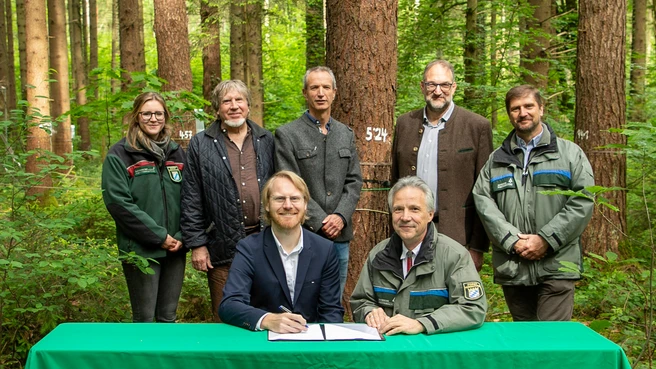In 1861, the former Kingdom of Bavaria established long-term monitoring plots in Bavarian forests to study wood growth and yield. The oldest monitoring plot still in existence today has been in operation since 1871: a beech forest in the Spessart region on the northwest edge of Bavaria.
This long-term research has repeatedly provided practical insights into forest growth. For example, important correlations between stand density and wood growth have been described.
Research on forest growth in mixed woods amid climate change
In the past, spruce played a key role in Bavaria's forestry sector, also outside its natural range. However, climate change has made it increasingly difficult for spruce to survive due to bark beetle infestations, and it is poorly equipped to withstand windstorms.
In recent years, the long-term monitoring network has been expanded to include monitoring plots with mixed forests, which provide important insights into their growth in climate change. The forest monitoring network currently covers 350 hectares across Bavaria, divided into 157 different monitoring sites with almost 1,400 plots.
TUM and LWF continue joint forestry research network
From the outset, the historical predecessor of the LWF was responsible for research at the long-term forest monitoring plots in collaboration with the university. Prof. Hans Pretzsch, long-time chair of forest growth science at TUM, is meanwhile emeritus.
Richard Peters, Professor of Tree Growth and Wood Physiology at TUM, and LWF President Dr. Peter Pröbstle have now signed an agreement confirming the commitment of both institutions to continued, long-term cooperation.
The TUM School of Life Sciences will continue to participate in the joint project group and will retain unrestricted access to the research data collected. Both institutions will provide sufficient personnel for the work on a permanent basis.
Dr. Peter Pröbstle’s and Prof. Richard Peters' prospects on forest growth research
“I am confident that this new agreement will enable us to secure and further develop this long-term forest monitoring network, which is unique in the world in this form. After all, we need reliable findings on forest growth to restructure forests in the face of climate change,” said LWF President Pröbstle.
“I see this cooperation as an opportunity to combine the unique strengths of both institutions, ensuring continuity and high-quality data collection”, states Richard Peters, Professor for Tree Growth and Wood Physiology at the TUM School of Life Sciences in Weihenstephan.
Prof. Peters uses dendrometers to measure tree growth: “Trees live for centuries, and to truly understand them we need long-term data. This cooperation enables us to embed our high-resolution sensor technologies into that perspective, paving the way for next-generation forest monitoring that combines established records with new insights.”
